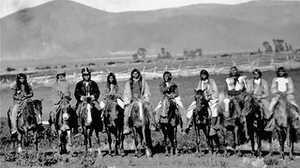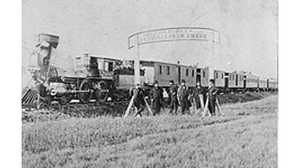Transcontinental Railroad: Reports from the End of the Track
Harper's Weekly reported on the progress of the transcontinental railroad throughout its construction. These excerpts, organized chronologically, report on conflicts with Native Americans, the terms of a peace treaty, the commercial benefits of the railroad for New York City, and the machine shops of Omaha.
June 22, 1867
The Indian War.
Operations on the Smoky Hill and Arkansas routes have ceased for the present, and the attention of General Sherman had been devoted to the Platte River route. At Omaha, on June 8, he issued general orders stating that the Union Pacific Railroad shall be so well guarded in the future that no Indians will dare to interfere with it. All passengers and freight must be forwarded to the end of the tracks, and from there will be guarded by sufficient escorts specially provided for that purpose. He expressed himself as sanguine that he will clear the Platte Valley of Indians within two weeks. He had also, with the concurrence of Secretary Stanton, agreed to allow Governor Hunt, of Colorado, to equip five hundred volunteers for Indian service.
July 27, 1867
New York as a Commercial Center.
...We have also expressed the belief that the constantly changing wants and exigencies of a growing country like ours demand, and will compel, a radical change in our present railway system; that with the completion of the grand arterial road across the continent to the Pacific, all other roads must become tributary and subservient to it -- the direction of railway traffic (freights) being traverse to the water communication that cuts the country from north to south. A consolidation of railroad interests will naturally result, as well as a change in the mode of operating and running. The future requirements are already foreseen and felt; the first movement toward the new order of things is the proposed combination of leading railroads to form a great Western route under one management. The parties to the combination are the New York Central, Lake Shore, Cleveland and Toledo, Michigan Southern, and those other roads that constitute the northernmost tier of transverse communication. Another rival organization is promised, to include a more southern route, and will embrace the Pennsylvania Central, Pittsburg, Fort Wayne and Chicago, etc. Their interests will not conflict; on the contrary, the commercial necessities of the country will on the course of time require one or two more routes still further south to convey the produce of the sea-board States to their western destination.
When the Pacific Railroad is completed in 1870, all these gigantic tributaries will converge toward the main stem, like the fingers of a hand. All the immense and richly productive districts of the Atlantic and the East will contribute to supply the vital fluid that courses through them. Even the vast domain of the "New Dominion" (traversed by the long-projected "Intercolonial Railway" and tapped by an absolutely indispensable line extending through Maine from Bangor) will be induced to furnish its quota of subsistence. But the seat of the vital principle will be in the city of New York. There will the mighty beat of its palpitation be heard. Already the commercial centre of America, it will then, by its geographical position, become the commercial centre of the world. We do not assume that the Pacific Railway will supersede vessels in the carrying trade, for that would be impossible; a dozen lines of railroad could not furnish the required transportation, even if it could carry as cheaply. But from its closer relations and proximity to other countries, New York could command the commerce. It would be as nearly united to Asia as it has been to Europe. The distance to China, now accomplished in forty-three to forty-five days, will be shortened to thirty days. A letter will reach Hong Kong by way of San Francisco much quicker than when it went by way of Liverpool, just as our enterprise had shortened the time of our communication with Brazil. The London banker would no longer pocket the commissions and the exchange on the immense trade carried on between New York and China, as well as South American and the West Indies; but New York would become, to America at least, what London is not to the rest of the world, namely, the place on which exchange is universally drawn. Millions of dollars would thereby be saved to our merchants annually, to say nothing of the difference of time, which is as precious as money.
We have heretofore spoken of the advantages to be obtained by the operation of the Pacific Railroad in developing the treasures of California and the Rocky Mountain region, and the easy access it afford to Asiatic trade. The gains, to be sure, are for the present purely speculative, but it is easy to conjecture the results from past experience. And we are to obtain all this by an estimated outlay of $45,000,000 currency for a road 1565 miles long, while the Intercolonial Railroad of the "New Dominion" of only 480 miles is expected to cost upward of $20,000,000 in gold. It will take rime to overcome the commercial and financial derangement which the late war inflicted upon the court, and to stimulate the productive interests of the several sections to their full capacity; but by the time the Pacific Railroad is completed we hope to lie upon the top wave of prosperity, and to tax our new lines of intercommunication to their utmost limit.
November 16, 1867
The Indian Peace Treaty.
A peace which might have been as readily arranged two years ago as at present was made with four of the tribes of Indians of the Plains in October at an Indian camp on Medicine Lodge Creek, Kansas. By its terms the location of the reservations of the Kiowas, Comanches, Apaches, and Cheyennes are changed and enlarged. The tribes are to remove farther south -- that is, away from the line in the Kansas branch of the Pacific Railroad, and are not to disturb the laborers on that route.
Our two illustrations... give the scene of the treaty and the council which concluded it. The full terms of the treaty give to each Indian on the reservation annually a suit of clothes, consisting of coat, pantaloons, hat, and socks, and in addition to this, $35,000 annually, in such articles as the Indians most need is to be given to the several tribes. Several other provisions are made to furnish seeds and agricultural implements to such Indians as may commence farming. The Indians agree to let all the railroads be built, and especially the Smoky Hill and Platte roads. They also agree to keep lasting peace; to capture no women or children; to attack no more trains, and to cease killing men; and it is also agreed to allow them to hunt on the old reservation, south of Arkansas, until the settlements drive them away from that hunting-ground.
July 23, 1868
The West.
Excursionists on the Union Pacific Railroad -- The Car Works and Machine Shops in Omaha -- A Glimpse of Mormon Immigrants.
From Our Own Correspondent.
Cheyenne, Dakotah, Thursday, July 23, 1868.
On Monday last, at the invitation of Mr. WEBSTER SNYDER, our party visited the car works and machine shops of the Union Pacific Railroad, at Omaha, and were not a little astonished at the magnitude of those works. The buildings are of brick, 200 feet by 80, with wing 80 feet by 40. Paint shop 160 feet by 35, with wing 40 feet by 16. As we entered the buildings the noise of twenty or thirty different machines all in motion -- the brawny workmen wielding ponderous sledge hammers -- the endless whirr of swift-revolving wheels -- the glowing metal, as it was taken at a white heat from the furnaces, scattering its bright sparks on every side -- all spoke of a busy, active life springing up here on these Western plains, where in our imagination we fancied we would see nothing but herds of buffalo and Indian encampments. As a general thing I don't like to bother myself with figures, but as I am writing for the information of your readers, I must, in order to enable them to form a correct idea of the extent of these works, go somewhat into detail. In the buildings above enumerated I noticed several circular saws, two plainers, three boring machines, two mortice machines, one turning lathe, one bolt cutter, one drill-press, one jig-saw, one shaping-machine, two tennouters, and two tennon-machines, and these all driven by a single stationary engine of the very finest workmanship. There are men who would call the din and noise created by these various machines, all whizzing away in a confused harmony, "The grand hymn of labor welling on through the ages," but I confess to me the whole place seemed a pandemonium, and yet not entirely without a certain fascination. In the main building were several locomotives of immense power and fine finish, most of them having been manufactured at Trenton, N.J., but put together here in the shops of the Union Pacific Railroad, where all repairs are done also. The Company manufacture most of their own cars, both freight and passenger cars. Twenty-four flat cars are being turned out each week, besides one first-class and one second-class coach, and one or two baggage-cars and cabooses each month. The first-class cars manufactured here are equal to any cars to be found on any of the Eastern railroads, and indeed the whole rolling stock of the Company will compare with that of any other road in the country. The lumber used is of three kinds, oak, ash and pine, all brought from Chicago and cut into proper lengths and thicknesses for the object designed. The material is first run through the plainer, which takes out all wind and smooths it; from there to the saw and again to the plainer; then to the mortice, tennons, boring, shaping and bolting machines, till it is at last ready for men employed for framing and bolting the car on the trucks which rest on the rails, extending through the whole length of the building. The car finished, it is transferred to the painting department, receives its different coats and stripes, and is then run back to the drying room. In this department there are three hundred and fifty hands employed, which, in addition to the cars manufactured, turns out a large amount of furniture and cabinet work for the use of the railroad offices and buildings along the track. In the forging and casting departments there are about the same number of workmen employed, and the average wages of the men is about $3.50 each per day, some getting as low as $2.25 and others as high as $4.75. For the above facts and figures I am indebted to the kindness of Mr. GAMBLE, who superintends the whole work, and also to Mr. FROST, the purchasing agent for the Company, who was unremitting in his attention to the party during our whole trip, accompanying us to the end of the road and explaining everything in detail.
As our party was returning from the workshops, in passing the depot of the Union Pacific Railroad, we encountered a lot of Mormon immigrants, some four hundred and fifty in number, waiting to be forwarded over the road as far as Cheyenne or Benton, where they take the overland route for the promised land. A motley crowd they were -- men, women and children, old and young, all haggard -- looking and travel-soiled. I should judge most of them were English, and certainly, from their dull, stolid appearance, they must have been selected form the lowest strata of society. Their condition certainly must be improved, both mentally and physically, even with all the drawback incident to Mormondom. A more woebegone and wretched-looking set of human beings I trust shall never see again, and yet hope must have been strong within the hears of many in that crowd, to enable them to bear up under the sufferings and hardships they must have endured since starting on their long pilgrimage. One poor woman stretched on the bare ground in a dying condition, with her husband tenderly doing all in his power to alleviate her sufferings, presented a pitiable sight indeed, but death, I learn, soon came to her relief, and here, almost on the verge of the promised land, after enduring heaven only knows how much of suffering and of agony, she passes away-let us hope to that better land where suffering is known no more.
On Tuesday, July 21, everything being in readiness, and having seen everything of interest in Omaha, we started for the end of the Union Pacific Railroad, and as this letter is quite long enough, I shall reserve the particulars of our journey for future notice. E.C.S.









